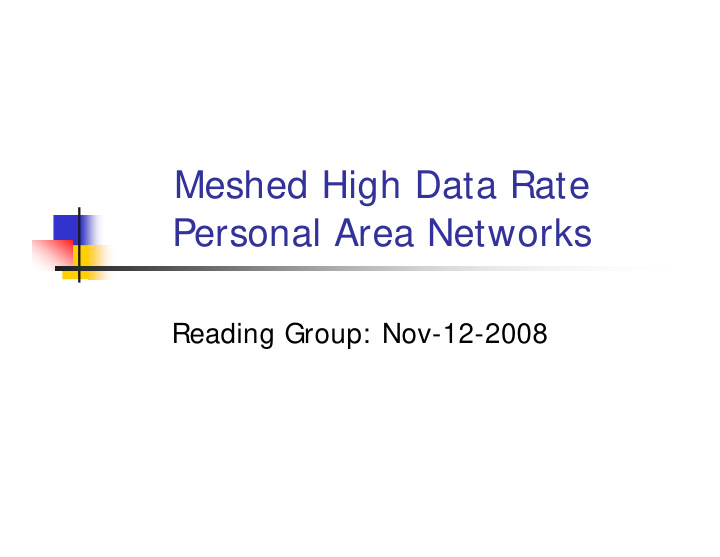



Meshed High Data Rate Personal Area Networks Reading Group: Nov-12-2008
Introduction � Big picture of the paper. � Bluetooth, Wireless PAN and WLAN. � Wireless Mesh Networks. 2
Overview of 802.15.3 Piconet, PNC, peer-to-peer communication. � Starting a piconet. � Child piconet vs neighbour piconet. � 3
Limitations of 802.15.3 � Parent-child and parent-neighbour model are not mesh configurations. 4
Impetus Behind Meshing PANs � Advantages of meshed 802.15.3 � Power � Reliability � Rout redundancy � Network Configuration 5
Architecture Extensions made to the high data rate PAN (802.15.3). � Issues faced by meshing PANs. � 6
Operation in a Mesh Configuration 1) Beacon Alignment � Two independent piconets might overlap. 2) Starting a Mesh Enabled Piconet 7
Operation in a Mesh Configuration 3) Network Self-Organization � Mesh Coordinator (MC). � Other MPNCs joins the tree > descendant number. � Disassociation. � Important issues: � High mobility of MDEVs. � Pragmatic value for descendants. 8
Operation in a Mesh Configuration 4) Address Assignment � Well-known techniques: � Hierarchical, centralized, distributed. � They are not suitable for tree MWPAN. � Tree topology should be known. � MC broadcasts a tree topology discovery frame. 9
Hidden Node and Exposed Node Problems � Hidden node problem: Request To Send/Clear To Send (RTS/CTS) � Exposed Node Problem: neighbour table (How?) 10
Routing Well-known ad-hoc routing algorithms can not be used. � Different algorithms: � Table � Using tree structure and TREEID � Centralized routing: topology server � Accurate measurements: coordinate system � Distributed routing: using rout discovery frame � 11
Recommend
More recommend